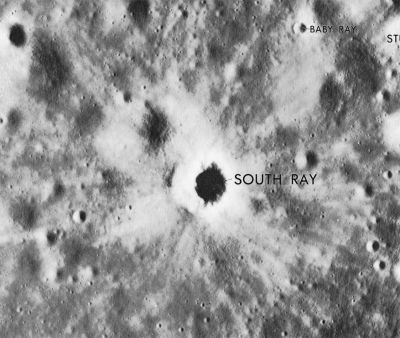Difference between revisions of "South Ray"
| Line 6: | Line 6: | ||
|} | |} | ||
<div id="toc"> | <div id="toc"> | ||
| − | [http://www.lpod.org/coppermine/albums/userpics/Apollo_16_South_Ray_crater.JPG [[Image: | + | [http://www.lpod.org/coppermine/albums/userpics/Apollo_16_South_Ray_crater.JPG [[Image:Normal_Apollo_16_South_Ray_crater.JPG|external image normal_Apollo_16_South_Ray_crater.JPG]]]<br /> ''[http://lpod.org/coppermine/displayimage.php?pos=-2247 Apollo 16 Site Traverses Chart]''<br /> <br /> |
==Images== | ==Images== | ||
[http://www.lpod.org/coppermine/thumbnails.php?album=search&type=full&search=South%20Ray LPOD Photo Gallery] [http://www.lpi.usra.edu/resources/lunar_orbiter/bin/srch_nam.shtml?South%20Ray%7C0 Lunar Orbiter Images] [http://www.lpi.usra.edu/resources/apollo/search/feature/?feature=South%20Ray Apollo Images] [http://www.lpi.usra.edu/resources/apollopanoramas/pans/?pan=JSC2007e045383 Panorama South Ray Crater]<br /> - Additional Apollo 16 photographs of the horizontal high-albedo streak officially known as '''South Ray Crater''':<br /> [http://www.lpi.usra.edu/resources/apollo/frame/?AS16-109-17770 AS16-109-17770] (above the television camera, near the horizon)<br /> [http://www.lpi.usra.edu/resources/apollo/frame/?AS16-109-17790 AS16-109-17790] (behind '''Plum''' crater)<br /> [http://www.lpi.usra.edu/resources/apollo/frame/?AS16-109-17797 AS16-109-17797] (behind astronaut John Young and the Lunar Rover)<br /> Research Apollo 16 photography: Danny Caes<br /> <br /> - '''South Ray Crater''''s interior (its chaotic floor and inner slopes) could be investigated at '''LON: 15.385 / LAT: -9.148''' ('''1 M/PIX''') in the LRO's [http://target.lroc.asu.edu/da/qmap.html ACT-REACT Quick Map].<span class="membersnap">- DannyCaes <small>Jun 26, 2011</small></span><br /> <br /> | [http://www.lpod.org/coppermine/thumbnails.php?album=search&type=full&search=South%20Ray LPOD Photo Gallery] [http://www.lpi.usra.edu/resources/lunar_orbiter/bin/srch_nam.shtml?South%20Ray%7C0 Lunar Orbiter Images] [http://www.lpi.usra.edu/resources/apollo/search/feature/?feature=South%20Ray Apollo Images] [http://www.lpi.usra.edu/resources/apollopanoramas/pans/?pan=JSC2007e045383 Panorama South Ray Crater]<br /> - Additional Apollo 16 photographs of the horizontal high-albedo streak officially known as '''South Ray Crater''':<br /> [http://www.lpi.usra.edu/resources/apollo/frame/?AS16-109-17770 AS16-109-17770] (above the television camera, near the horizon)<br /> [http://www.lpi.usra.edu/resources/apollo/frame/?AS16-109-17790 AS16-109-17790] (behind '''Plum''' crater)<br /> [http://www.lpi.usra.edu/resources/apollo/frame/?AS16-109-17797 AS16-109-17797] (behind astronaut John Young and the Lunar Rover)<br /> Research Apollo 16 photography: Danny Caes<br /> <br /> - '''South Ray Crater''''s interior (its chaotic floor and inner slopes) could be investigated at '''LON: 15.385 / LAT: -9.148''' ('''1 M/PIX''') in the LRO's [http://target.lroc.asu.edu/da/qmap.html ACT-REACT Quick Map].<span class="membersnap">- DannyCaes <small>Jun 26, 2011</small></span><br /> <br /> | ||
Latest revision as of 02:18, 16 April 2018
Contents
South Ray (aka South Ray Crater) (Apollo 16 site craterlet name)
|
Lat: 9.2°S, Long: 15.4°E, Diam: 0.68 km, Depth: 0.135 km, Rükl: 45, Copernican |
Apollo 16 Site Traverses Chart
Images
LPOD Photo Gallery Lunar Orbiter Images Apollo Images Panorama South Ray Crater
- Additional Apollo 16 photographs of the horizontal high-albedo streak officially known as South Ray Crater:
AS16-109-17770 (above the television camera, near the horizon)
AS16-109-17790 (behind Plum crater)
AS16-109-17797 (behind astronaut John Young and the Lunar Rover)
Research Apollo 16 photography: Danny Caes
- South Ray Crater's interior (its chaotic floor and inner slopes) could be investigated at LON: 15.385 / LAT: -9.148 (1 M/PIX) in the LRO's ACT-REACT Quick Map.- DannyCaes Jun 26, 2011
Maps
(LAC zone 78D2) LAC map Geologic map LM map LTO map Topophotomap 78D2/S1
Description
South Ray is one of the high-albedo ray craterlets near Apollo 16's landing site which are already observable through common telescopes. The best time to observe both ray craterlets (North Ray and South Ray) is during Full Moon. It is not known if the much smaller Baby Ray (near South Ray) is also detectable through powerful telescopes. A good specialist of telescopic Hi-Res webcam photography could come up with the answer...
This crater (South Ray) is a very fresh simple crater, 680 m in diameter. Samples collected date it as 2 million years old, the youngest material collected during the Apollo missions.
Description: Wikipedia
South Ray crater (correct link)
Additional Information
The Landing Site Name "South Ray" is plotted on Site Traverses chart 78D2S2.
Nomenclature
Astronaut-named feature, Apollo 16 site.
LROC Articles
Bibliography
APOLLO OVER THE MOON; A VIEW FROM ORBIT, Chapter 5: Craters (Part 1), Figures 105 and 106.
George E. Ulrich, Henry J. Moore, V. Stephen Reed, Edward W. Wolfe, And Kathleen B. Larson (19xx) Ejecta Distribution Model: South Ray Crater.
David M. Harland: EXPLORING THE MOON, the Apollo expeditions.
Eric M. Jones: APOLLO LUNAR SURFACE JOURNAL (ALSJ).
